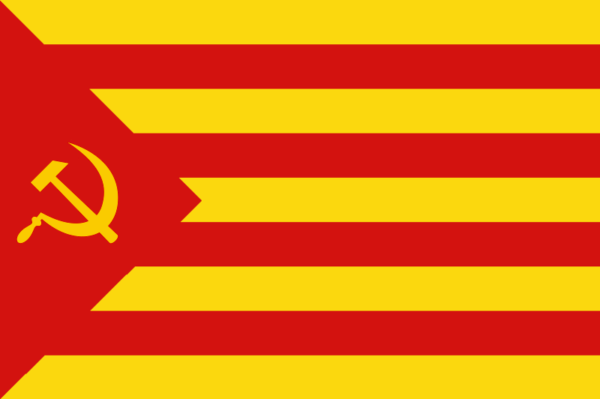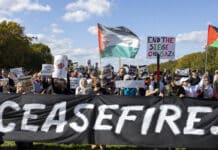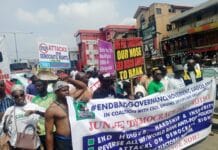For a socialist Republic of the working class and youth!
Esquerra Revolucionària (CWI in Catalonia)
This 11 September – the ‘Diada’ (National Catalonia Day) – Barcelona’s Avenida Diagonal thoroughfare overflowed with around two million people in an unprecedented mass mobilisation. Once again the people of Catalonia have seized the streets – to shout loud and clear their rejection of the repression of the Spanish state, to call for the freeing of political prisoners and return of those in exile, and to demand that the republic they voted for overwhelmingly on 1 October 2017 (1-O) at last be realised.

Masses say yes to republic – reactionary Spanish nationalist demo a farce
This mobilisation was the culmination of a day of struggle which – from the first hours of the morning through to the night – took hold of various parts of the Catalan capital, paralysing some of them. There were massive actions across the city, such as at the Fossar de les Moreres plaza, Mercat de Born cultural centre, Arc de Triomf monument, and Plaça Catalunya and Urquinaona squares. Some days before 11 September, more than 440,000 people had already said online that they would take part in the demonstration. 1,500 buses had been chartered from different localities in Catalonia to come to the capital. 275,000 t-shirts had been sold to help finance the mobilisation. All these figures, superior to previous Diadas, are the best answer – together with the incontestable pictures of the masses overflowing Diagonal – to all the attempts to obscure or downplay the scale of participation in this historic day.
This human tide in support of the Catalan republic contrasts with the resounding failure of the organisers of ‘In Defence of the Unity of Spain’ or ‘Diada of the Alternative to Independence’ – organised respectively by the far-right Catalan Civil Society and Vox party, and the right-populist Ciudadanos party. The pathetic images of Albert Rivera, leader of Ciudadanos in Spain, and Inés Arrimadas, its leader in Catalonia, received by barely a hundred of their supporters in the city centre Plaza del Rei de Barcelona, sum up the failure of these reactionary, Spanish-nationalist elements who attempt to declare themselves the voice of the “silent majority” of Catalan society, and put them in their place.
The leaders of the reformist left – the tops of Podemos, Izquierda Unida (United Left), the CCOO and UGT unions – and also the leaders of the Esquerra Republicana de Catalunya (Republican Left of Catalonia – ERC), must take note of this message of strength, drive and decisiveness sent to them by the human tide which overflowed Diagonal and the adjacent streets this Diada. The contrast between this tremendous show of force, and the tiny capacity for mobilisation shown by the defenders of the post-Franco ‘regime of ’78’, monarchy and ‘one Spain, great and free’, could not be more abysmal! How is it possible to go on maintaining – like ERC deputy in the Spanish parliament Joan Tardá, and ERC vice-president of the Catalan government Pere Aragonés recently have – that “it would be stupid” or “it’s not possible” to take the republic forward because Catalonia is divided 50/50?
Faced with the impossibility of hiding the success of this Diada, the bourgeois media – Spanish and Catalan – chose to recognise it was massive, but attempted to present it as just another day, minimising the numbers participating. Many of these same leaders – of the conservative Catalan-nationalist PDeCat, JxCat independence coalition, and ERC – who spent months propagating the idea that it’s not possible to realise the republic because “there is not sufficient strength,” have received an inarguable answer.
The impressive aerial photographs which have gone round the world show more than 6km of Diagonal – one of the longest and widest avenues in Barcelona – packed with demonstrators; let no one doubt it. If we compare these pictures and their size with other demonstrations – for example the million people who filled the 4km of the Avenida Marina thoroughfare on 11 November 2017 calling for freedom for political prisoners – we are without doubt looking at the most massive social mobilisation since the general strike which paralysed Catalonia on 3 October 2017, when between two and three million came out onto the streets across Barcelona and the major cities of Catalonia.
Continue the movement in the streets until the mandate of 1-O is fulfilled
This massive mobilisation was even more significant when you take account of the fact that it came after a year of constant repression on the part of the state apparatus. This has included political trials, exceptional measures like article 155 (of the constitution which suspends the power of a regional government), and the refusal of the PSOE government to accept the right to self-determination for the people of Catalonia. Most importantly of all, it came after three months of demobilisation – ‘cold water’ being poured on the movement – by PDeCat, but also by many of the leaders of JxCat and the ERC.
That political approach – of rejecting participation in the demonstrations and actions which took place on Catalan national day – has also been adopted by Ada Colau and the leaders of Podemos and ‘Catalonia in Common’ – a Left alliance involving Podemos and the IU in Catalonia.
In an unjustifiable declaration, Ada Colau and the leaders of Podemos joined in with arguments of reactionary Spanish nationalism saying that the Catalan national day reinforces ‘unilateralism’ and the division of Catalan society. In practice, they renounce the principle of the right of the Catalan people to decide their own future, a right which not so long ago they defended, and which won them mass support from the population.
This political turn brings them in line with the parties of ‘155’. It has provoked surprise and revulsion among the vast majority of the workers and youth who voted for Colau and for ‘Barcelona in Common’.
Their failure consistent support for the liberation of the people of Catalonia with a consistent policy, linking the struggle for a Catalan republic with the fight against the capitalist ‘regime of 1978’ and for workers’ Republics in the rest of the territories which make up the Spanish state, is a grave error that will cause great difficulties.
This Catalan national day demonstrated that the mass movement for a Catalan republic is not only alive and well, but is prepared to fight to the end. This will not happen without tens of thousands of people beginning to question why the mass force demonstrated on the streets collides ever more clearly with the tendency of certain political forces to seek to hold back the movement. These are the forces which look for agreements ‘from above’ with a state and a government that refuses to negotiate anything other than the movement’s surrender.
The dissatisfaction with this situation is shown by the proliferation of slogans on posters and stickers like “make the republic now!”, “self-determination is not negotiated, it is exercised”, and so on. It is also shown in the criticism made by ANC speakers, as well as by those from the CUP and other organisations, of the previously mentioned idea that that the mandate of ‘1-0’ cannot be carried out because it will “provoke mass division”.
This once again confirms that within the movement for Catalan national liberation there are two fundamentally opposed political approaches. The first represents a small minority among the masses, but it today both sets the pace and dominates in government. This approach attempts to place a break on the movement and to reach an agreement with the Spanish capitalists, which would really mean shelving the Catalan republic. Confronting this approach is the immense majority of workers, youth, and broad sections of the middle classes that want to advance towards a republic of workers, youth, and the people, in order to see a solution to the current social problems, and a break with capitalism, as well as the regime of 78.
For that to happen, the left needs to struggle for leadership in the movement for national liberation on the basis of such a socialist programme, fighting to sustain the mass mobilisations and, in that way, to unite the majority of the Catalan working class, including those layers hit by the crisis of capitalism, which reject the reactionary ideas of the PP and Ciudadanos, but which so far show distrust towards the independence movement because of their hostility towards the leaders of the PDeCat and the Catalan right, from whom they have only received attacks and cuts.
Today, more than ever, it is essential to build a united front of the left to struggle for a Socialist republic of the workers’ and youth – bringing together the CUP, the CDRs, fighting trade unions, women’s rights movements, students, and social movements – in order to carry the movement forward to victory.




